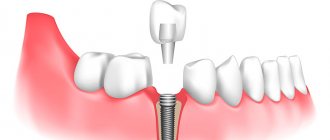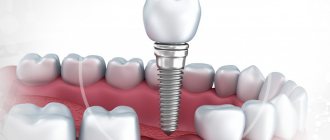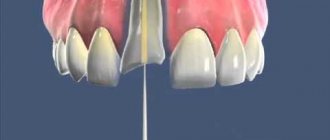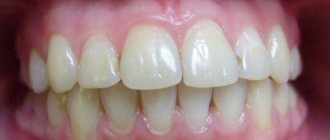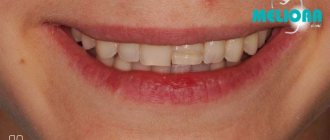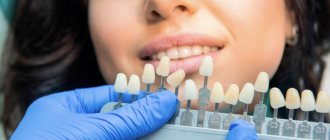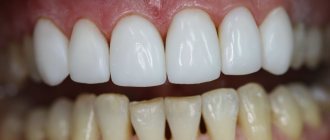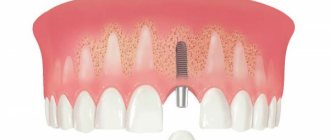Veneers are dental microprostheses in the form of dental onlays for covering the front teeth. They are a durable plate that covers the front part of the tooth and goes to its cutting edge. With the help of veneers, it is possible to give front teeth with various defects an aesthetic appearance with the natural color of your own teeth. They are an excellent alternative to conventional dental restoration. Veneers, the pros and cons of turning uneven teeth into a Hollywood smile are described in our article.
Veneers: disadvantages and advantages
Veneers are used to restore the outer surface of tooth enamel. They differ from artificial crowns:
- partial closure of the tooth surface (crowns are a “cap” that covers the tooth, including from the sides);
- To install veneers, the enamel is partially ground off (it is enough to remove a layer 0.5-1 mm thick)
- used only for the restoration of front teeth (incisors, canines, less often premolars), which are visible when smiling or talking.
The common advantage of all veneers is the achievement of a good aesthetic result with the least traumatic effect on the tooth. The main disadvantages include the fact that veneers cannot solve all aesthetic problems. Other pros and cons depend on the type of veneers and the materials from which they are made.
The main disadvantages and advantages of different types of veneers
| Type of veneers | pros | Minuses |
| Removable | They cost less than any professionally manufactured microprostheses, are purchased ready-made, and do not require the participation of a dentist. | Not suitable for long-term wear. Very low aesthetic effect |
| Composite ready | Quite low cost, do not require individual production. | Fragility Poor aesthetics |
| Ceramic | Durability, best aesthetic effect. | High price. |
| Liquid | Lowest price, no need to make impressions. | Low aesthetic effect, shortest service life. |
Questions and answers
Is it true that empress veneers installed in your clinics do not require grinding or removal of enamel?
Good afternoon Please tell me, is it really true that the empress veneers installed in your clinics do not require grinding and removal of enamel? In connection with what?
Hello! To install Empress veneers, grinding of the enamel is required to better attach the veneer and give the teeth an anatomical shape, but the grinding is not as deep as when installing other types of veneers, since Empress veneers are ultra-thin plates made of a unique high-strength material. You can find out more detailed information about the properties of Empress veneers and the features of their installation during a free consultation with our orthopedists. You can make an appointment by calling + 7 (495) 789-42-02. Sincerely, Patient Support Center SIMPLADENT++8 800 333-53-41
Is it possible to hide or disguise a crooked tooth with a veneer?
Good afternoon Tell me, is it possible to hide/disguise it with a veneer if a tooth is crooked? On my right, the fang goes inside the jaw. I don’t want to get braces, and I can’t afford the money for mouthguards. It seems like the solution is veneers, but I need your preliminary advice.
Hello! Theoretically, such defects can be corrected by installing veneers. However, only a doctor can answer you for sure based on the results of the examination. Come to our specialists for a free consultation, the doctor will explain to you all the details of veneer prosthetics and write out a treatment plan indicating the cost. Our clinic uses highly aesthetic Empress veneers made from ultra-strong ceramics. For more details and to sign up for a free consultation, please call +. Sincerely, Patient Support Center SIMPLADENT++8 800 333-53-41
Other questions
Other jobs
Removable veneers: pros and cons
Removable veneers are a structure that is applied to the entire dentition of the upper and lower jaw (you can purchase such an overlay only for the upper or lower teeth). These veneers are made of plastic and are placed on top of the teeth. Dental glue or silicone is used for fixation. The pads are worn as needed (at work, during a photo shoot), then removed. These products are not dental prostheses; they can be purchased (and used) independently, without consulting a doctor, for relatively little money: the price does not exceed 2000-3500 rubles. The most common among them:
- Perfect smile veneer . Made in the form of a continuous curved strip, imitating gums with teeth, which is superimposed on the front part of the jaw.
- Snap-On Smile . They resemble an orthopedic splint or mouthguard that covers both the outer and inner surfaces of the teeth (without gums), and is put on like a cover over the dentition. There are holes for the chewing surfaces of the lateral teeth. The design is made of thin plastic, so it creates minimal discomfort when wearing. This is a better model.
The advantages of removable veneers are much less than the disadvantages:
- they can be installed from above, without first removing the enamel layer - this is the main advantage of removable structures;
- unlike permanent microprostheses, a removable onlay masks the absence of individual teeth - another undeniable plus;
- low cost, affordable for many people.
Disadvantages of removable dental veneers:
- This design looks like natural teeth only from a distance (Perfect smile veneers also have an unnaturally bright color of the artificial “gum”);
- poor fixation - the false “jaw” can move or fly out at the most inopportune moment;
- fragility - it is better to remove the device while eating, otherwise the pad will quickly become unusable;
- can protrude lips due to additional volume;
- distort diction;
- create a feeling of discomfort;
- Wearing removable veneers for a long time during the day is harmful - the teeth in them are poorly washed with saliva, which over time leads to thinning of the enamel, and the accumulation of food under a poorly fitting veneer increases the risk of caries.
Before purchasing a removable structure, it is useful to study the comments on review sites - many models are rated by the authors as completely unsuitable for use. To avoid the progression of existing diseases of the teeth and other organs of the oral cavity, it is recommended to consult a doctor before purchasing.
Expert opinion: everything you need to know about veneers
Money can't buy happiness, but it can buy a perfect smile.
Lindsay Lohan, Kylie Jenner, Miley Cyrus, Melania Trump, Scarlett Johansson, Tom Cruise, Demi Moore - all these celebrities once installed veneers and became the happy owners of snow-white, perfectly straight and beautiful teeth. Together with an expert dentist, we understand all the intricacies of the expensive procedure. According to the ADA (American Dental Association), 80 percent of people would like to improve their dental health. Among all the possible options for correcting a smile, veneers are becoming increasingly popular - thin plates covering the tooth surface from the outside. We asked experts to answer the most common questions about the currently fashionable procedure.
What are veneers and how to distinguish them from natural teeth?
Veneers are thin ceramic overlays that are used to restore and strengthen a tooth, and also improve its appearance (shape and color). Simply put, it is new enamel on the tooth. A well-made veneer cannot simply be removed. It can only be ground off the tooth. That is, the veneer, in fact, will already be part of the tooth. A high-quality veneer is practically indistinguishable from a tooth; it looks very natural, natural and beautiful,” says Alexander Khan, chief physician of the Dental Profi dental clinic, Ph.D. How to know if you are a suitable candidate for veneers. In what cases can you not get by with mouthguards or braces?
Using magnifying devices (microscope and binoculars), dentists can make ultra-thin veneers and grind off microns of dental tissue without harming the tooth. The expert explains that the intervention of an orthodontist is required when it is necessary to correct the position of the teeth (for example, due to crowding) with the help of aligners and braces. Sometimes patients come asking for veneers, but first they need to undergo orthodontic treatment. Their teeth are actually pretty good quality, but they are so crooked that they don't realize it. The proper treatment is to straighten them and possibly bleach them, says NYC Smile Design dentist Elisa Mello.
Who can't get veneers?
There are not many contraindications to installing veneers. We will not consider difficult situations related to general health. One of the local contraindications is the absence of lateral chewing teeth, which can affect the service life of the front teeth themselves, and not just the veneers. Another contraindication is severe crowding of teeth - there is not enough space in the jaw for teeth. If you have gum disease (periodontitis), we won’t be able to place veneers right away, so the gums are treated first,” says Alexander Khan.
What are veneers made of and how to choose the right size?
Veneers are made from a special ceramic material. First of all, the doctor selects the size and shape of the veneers. There is a special technique for this - “Digital smile design”. Using it and taking a series of photographs, you can pre-model the future shape of the veneers on a computer. Then the doctor agrees on this form with the patient, makes try-on veneers, agrees again, and only then begins production. If everything is done correctly at each stage, your smile will be perfect.
How does the installation take place and is it true that your teeth are not actually ground down?
The doctor installs one or two veneers. You cannot glue all the veneers at once. The fixing adhesive is so strong that it can be very difficult to remove. Usually it takes 15-30 minutes to fix one veneer, sometimes longer.
The teeth do not actually wear down, because most often we, on the contrary, increase the size of a worn or destroyed tooth. Our equipment allows us to extend tooth preparation with pinpoint precision and minimal grinding of tissue,” explains the expert.
During installation, fifty percent of patients feel the veneer bond to the tooth. The discomfort may last up to six hours after the anesthesia wears off. Doctors recommend taking ibuprofen during this period of time. A few days after the procedure, an adaptation period begins; a dull pain may occur while eating.
Are there any contraindications after installing veneers?
There are no contraindications after installing veneers. You can eat, drink, chew everything that can be done with regular teeth. If you treat veneers as carefully as you treat your own teeth, then nothing will happen for many years. I usually tell patients that if there is something that can break your own tooth, then it will break the veneer. You don't have to change your lifestyle because you got veneers, but you do need to be careful, says Dr. Ramin Tabib.
Will it be possible to remove the veneers after approximately 10-15 years? What will your teeth look like without them?
According to Alexander Khan, it will not be possible to simply remove veneers, just like lumineers. The fact is that the veneer is one piece with the tooth, so it can only be ground off. It is ideal to do this so that the tooth remains the same as it was before the veneer was installed, but it will not work. The expert admitted that such situations when it is necessary to grind off veneers are extremely rare in his practice. Therefore, you need to understand that veneers are made forever.
Why are veneers so expensive?
A high-quality veneer requires the skill of a dental technician and doctor, modern expensive equipment and materials, extensive experience, and so on. The work of a master cannot be cheap. At the moment, we can say that we have reached the level of world dental practices and use the best world techniques in the manufacture of veneers. This is confirmed by the large number of patients coming to us from abroad. In the West, services of this level are much more expensive (from four thousand dollars), the expert answers.
How to take care of your teeth then?
After installing veneers, caring for your teeth is absolutely the same as without them. It involves proper, thorough brushing of your teeth twice a day (preferably with a toothpaste without large abrasive particles), cleaning out gaps with floss and an irrigator, and regular dental checkups.
Composite veneers: pros and cons
Composite veneers (componeers) are a relatively new material for aesthetic restoration, which has appeared in dental practice since 2011. Ready-made half-crowns are produced en masse, of standard sizes (not according to individual impressions), from a semi-liquid polymer material, similar to modern fillings, which hardens under the influence of light and temperature. The doctor installs ready-made pads, grinding them to size directly during the appointment.
Componer advantages:
- compared to liquid composite veneers - greater strength (10 years or more - there is no exact data yet, since they began to be used recently) and a more natural appearance; due to the smoother surface, frequent polishing is not required;
- compared to ceramic half-crowns - quick installation and affordable price (from 15,000 rubles per tooth).
- suitable for restoring several teeth;
- Available in a wide range of colors and various shapes;
- easily repaired directly in the patient's mouth using liquid composite polymer.
Minuses:
- susceptibility to scratches and chips;
- the ability to quickly stain from food and drinks;
- less beautiful appearance than ceramic veneers.
Componeers are a good economical alternative to expensive ceramic veneers.
Care
To increase the service life of the plates, it is necessary to organize their care:
- Clean your mouth daily Veneers are processed using floss, toothpastes and soft-bristled brushes.
- Avoid mechanical damage to the jaw.
- For bruxism, purchase special plastic plates These protective elements will protect the veneers from displacement.
- Avoid eating foods that contain large amounts of dyes - soda water, beets, carrots.
If you follow all the rules for caring for the products, veneers can last about 10 years
Ceramic veneers: pros and cons
Ceramic veneers are the best option for restoring the surface of the front teeth. They are made in a dental laboratory using individual impressions. It is best to restore not just one tooth with such crowns, but two to eight at once. Their advantages include:
- the most natural and beautiful appearance of teeth due to the fluorescent surface, the ability to give the material any shade that matches your own enamel;
- smoothness, ensuring easy care and good hygiene (there is less plaque accumulation on the ceramic surface);
- hypoallergenic;
- high resistance to staining;
- low abrasion;
- strength and durability – ceramic veneers last up to 20 years.
Disadvantages of ceramic veneers:
- the highest cost compared to onlays made from other materials (the price of one half-crown ranges from 30,000 rubles);
- long process of dental restoration;
- difficulty in repairing – it is very difficult to achieve a good effect when chipping such a veneer; They need to be removed for repairs.
Depending on the base material, ceramic veneers are divided into:
- Porcelain . They are made by hand from porcelain with various additives by casting or pressing. Porcelain plates can be slightly translucent, due to which the shade of the restored teeth does not differ from the color of neighboring healthy ones. The thinnest (and most expensive) type of porcelain veneers are laminiers, popular among Hollywood film actors.
- Zirconium dioxide . These veneers are made in an automated way (using robotic CAD/CAM equipment) - they are cut out from a single block. Most often, the base of a half-crown is made from zirconium dioxide, which is covered with another type of ceramic on top. These are the most durable and light-proof overlays, practically not susceptible to chipping. They are suitable for the most difficult cases, when the diseased tooth has darkened to such an extent that when viewed through the ceramic, it is very different in color from healthy ones. All-zirconium plates made using Prettau technology are successfully used in dental restoration in patients with bruxism.
Differences between E-max and other models
E-max models differ from conventional veneers in that they are as gentle as possible on the tooth surface. They are very thin and can be compared to Lumineers. But, thanks to the source material - strong pressed ceramics, they are very durable. They are attached to the tooth with a safe compound, fixed with the light of a special lamp.
Of course, you shouldn't crack nuts, but E-max is much more durable than other analogues. There are no microcracks when installed on defective teeth. It is guaranteed that bacteria will not get under them. No extensive enamel processing is required. The risk of chipping is minimal.
To create them, durable reinforced glass ceramics (pressed leucide) are used. They are made only taking into account the anatomical features of each person.
The shape of everyone’s teeth is different; veneers make your smile beautiful, but not toy-like. Therefore, individual proportions and crown sizes are observed.
Liquid veneers: pros and cons
As in the manufacture of composites, a composite material is used for restoration with liquid veneers. The only difference is the prosthetic technology: the composition is applied directly to the prepared tooth, bypassing the stage of manufacturing the onlays. It is advisable to restore no more than one or two teeth with liquid veneers.
Advantages of liquid veneers:
- relatively low cost (from 15,000 rubles per tooth);
- quick installation;
- ease of repair;
- the ability to restore sufficiently large damage to the dental crown.
Flaws:
- poor resistance to mechanical stress - easily chipped, scratched, requires regular professional polishing;
- not very durable - service life is no more than 5 years (on average 2-3 years);
- easily stained when eating fruits, berries, strong tea, coffee, or smoking;
- Suitable for restoring teeth with minor enamel damage.
Why are veneers so expensive?
The cost of veneers is influenced by many factors. And the most important of them: the price of the material and the manufacturing method. Thus, composite onlays, which are formed directly in the patient’s mouth, cost no more than installing a crown. But the manufacture of ceramic veneers requires high professionalism and a significant investment of time from the dentist and dental technician.
First, an imprint of the tooth is made, then an impression is made, from which the technician will manually sculpt the future plate layer by layer. The process of making veneers is completed by firing in an oven. Thus, the creation of an onlay that is visually indistinguishable from a tooth can only be compared with the birth of jewelry: the work must be so professional and precise. And, of course, it simply cannot be affordable!
Author: Alexander Yaganov Orthodontist. Work experience more than 7 years.
The information is for reference only. Before treatment, consultation with a doctor is necessary.
Benefits and harms of veneers
Installing veneers entails both benefits and certain harms. The benefits are:
- an impeccable smile is a guarantee of self-confidence and promotes success both in your career and on the personal front;
- in reliable protection of the closed surface from mechanical, temperature, chemical influences, caries.
Harmful points:
- the ground surface of a tooth without veneers is defenseless against adverse effects and has an unsightly appearance - after the first installation, they will have to be replaced with new ones (except ceramic ones) as they become unusable throughout life.
Before installing veneers, it is useful to weigh all the pros and cons, and ask yourself whether it is worth prosthetics for healthy, albeit not entirely ideal, teeth for the sake of the fashion for a snow-white smile.
Types of ceramic veneers
At the moment, there are two types of ceramic veneers - from pressed ceramics and from ceramics made using a refractor. Essentially they have no differences, but they are installed and processed differently. Let's look at how ceramic veneers are made:
Pressed ceramic veneers
This method of making veneers involves first making a wax model, on the basis of which ceramics are pressed under high pressure. This allows you to very accurately convey all the features of the appearance of the patient’s tooth enamel and make the inside of the veneer exactly adjacent to the tooth.
Veneers made using a refractor
When manufacturing using a refractor, a special refractory base is first made, onto which ceramics are applied in layers, and then this structure is baked in a special oven.
IMPORTANT:
Specialists at the German Implantology Center can produce ceramic veneers of any type. Any veneers are made individually for each patient, and the quality of their installation meets the highest standards.
How to place veneers
The prosthetic process depends on which veneers are chosen - direct or indirect. The first includes liquid veneers made of composite material, the second includes all others.
Installation of direct veneers
Installation of liquid veneers consists of the following steps:
- Initial appointment with the dentist (assessment of the condition of the oral cavity, identification of indications for a particular type of veneers and contraindications for their installation, agreement with the patient on the cost of the work).
- Grinding off 0.3-0.5 mm of enamel from the outer surface of the tooth. Without this, its shape when the veneer is installed will be convex and the color unnatural. This procedure is usually not painful, but can be performed under local anesthesia if the patient wishes.
- Layer-by-layer application of material to each prepared tooth, grinding, polishing.
The entire process can be completed in one session. Before installing veneers, failed fillings are removed and caries and its complications are treated. After dental restoration, the doctor gives recommendations on how to care for the veneers so that they last and remain in good condition for as long as possible.
Installation of indirect veneers
Stages of prosthetics with indirect veneers:
- Determination of indications and contraindications, discussion of the pricing issue with the client.
- Taking impressions for making veneers.
- Grinding the tooth surface.
- Protection of the prepared tooth. This stage is necessary to protect the damaged surface from adverse effects, normal food intake, preserve the gingival contour, and prevent displacement. For this purpose, the machined surface is sealed with a special compound - a desensitizer. A temporary filling is used to close a large defect.
- Manufacturing of veneers. It takes from one day depending on the type.
- Installation of veneers. The doctor fixes the microprostheses using special glue. Additional minor sanding may be required to ensure a better fit. After installation, the onlays are carefully ground and polished to maintain a normal bite and prevent soft tissue injury from sharp edges.
Indirect veneers are installed in 2-3 visits. The exception is compositors that do not require individual manufacturing - they can be installed in one visit.
Lumineers
Lumineers are the most expensive and completely harmless option for creating a beautiful smile. They are very thin plates of porcelain. They are 2 times thinner than veneers, much stronger and look more natural in the oral cavity. To install them, no additional treatment of the teeth is required (part of the enamel is not worn down). Installed in a short time and absolutely painlessly. Such dentures are manufactured only in America; in this country there is a special laboratory for their manufacture, where the technology for the production of dentures - lumineers - was patented. The main advantage of such onlays is that they can be removed at any time without damaging your teeth. The installation of lumineers is harmless, does not affect the sensitivity of the enamel and does not cause discomfort.
With the introduction of technology in the dental services market for the production of veneers and lumineers, many people have the opportunity to achieve a beautiful Hollywood smile. Only a small number of people are born with beautiful and straight teeth. The biggest disadvantage of creating such a smile is the very high cost. Despite this factor, installing veneers can make your long-standing dream come true - to have snow-white and straight teeth. Making braces and regular chemical teeth whitening together will not cost much less.
Sources used:
- “Ceramics in Dental Restorations – A Review and Critical Issues.” Azom. October 8, 2002
- “Criteria for evaluating composite dental restorations” (Nikolaev A. I.)
- Principles of operative dentistry. Qualtrough, A. J. E. Oxford, UK: Blackwell Pub. 2005.
Indications for installation of veneers
Situations when veneers give good results:
- discoloration of teeth that cannot be corrected by modern whitening methods (age-related changes, pigment spots, fluorosis)
- some changes in the shape of the teeth (chips, wedge-shaped or spiky teeth);
- disorders of the enamel - congenital underdevelopment, tendency to wear away, cracks;
- weakly expressed inclinations and rotations of teeth;
- presence of gaps between teeth;
- gummy smile (veneer allows you to make the dental crown higher);
- incomplete tooth eruption;
- the presence of small darkened fillings.
Examples of work “Before” and “After”
Restoring aesthetics with lumineers
Case: the patient complained of unsatisfactory aesthetics of the anterior teeth (yellow enamel, curvature).
Aesthetic restoration of anterior teeth - lumineers
Case: the patient complained about the unsatisfactory aesthetics of his smile (he was not satisfied with the color and shape of the teeth), since the teeth were not affected by caries, the curvature was small, the patient chose the most non-traumatic restoration option - installing lumineers without grinding and depulping the teeth.
Contraindications for installing veneers
Prosthetics with veneers are not used in the following cases:
- absence of lateral teeth;
- malocclusion (except minor degrees), severe dentition disorders;
- caries, its complications (pulpitis, periodontitis), periodontitis, periodontal disease;
- acute diseases of other organs and tissues of the oral cavity;
- bruxism;
- bad habits that have a detrimental effect on the safety of microprostheses - gnawing on objects in moments of excitement or thoughtfulness, opening bottles with teeth, cracking nuts;
- destruction of most of the dental crown;
- allergies to the medications used and components in the veneers.
It is extremely harmful (and life-threatening) to install any dentures during an exacerbation of cardiovascular, renal, and pulmonary diseases. In case of a stroke or myocardial infarction, veneers can be installed only after six months.
offers patients a choice of high-quality veneers made using the most modern technologies - such onlays do not have to be changed frequently. Experienced doctors who regularly undergo training in Western clinics will provide qualified assistance in preparing for prosthetics and install the onlays as safely and painlessly as possible.
Veneers help your dreams come true!
Dreams Come True! And a snow-white smile zone has already become a reality for everyone. Cosmetic dentistry in action! An easy and effective way to achieve an ideal set of teeth is with veneers; they are installed quickly. It's easy to choose material for any budget.
Some of my advertising:
High-quality and aesthetic Emax veneers, only advanced gentle techniques, thanks to which dental restoration will take place without pain and in a comfortable environment.
The most beautiful veneers
will be made for you by me, Sergei Sergeevich Samsakov, an orthopedic dentist with more than 10 years of successful experience. What makes my veneers different from others:
